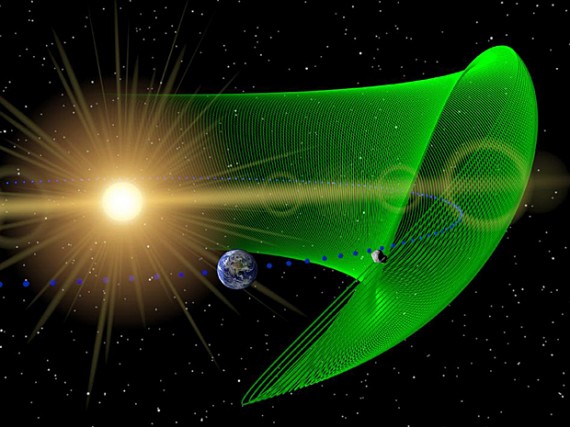Scientists Discovery “Trojan Asteroid” Sharing Earth’s Orbit
Apparently, Earth isn’t alone in the track it takes in its journey around the Sun:
The moon isn’t the only hunk of space rock that has been travelling around the sun with the Earth for ages.
Canadian scientists have discovered that the Earth is also accompanied by a “Trojan” companion — an asteroid that travels a constant distance ahead of it at all times, sharing nearly the same orbit around the sun.
Similar objects have been found travelling with other planets in our solar system, including Mars, Jupiter and Neptune.
“In a way, these are sort of like secondary moons,” said Martin Connors, the Alberta scientist who led the discovery published in Thursday’s issue of Nature.
Like the moon, the asteroid known as 2010 TK7 is under the control of Earth’s gravity and has been orbiting stably with the Earth for at least 10,000 years. However, Trojans are not satellites — unlike the moon, the Trojan asteroid does not orbit the Earth. Viewed from the Earth, the asteroid sits 60 degrees from the sun.
“You would think that the gravity of the planet would just like to pull the asteroid in,” said Connors. “But when it does do that, it moves closer to the sun, and then the sun’s gravity makes it go faster, and it pulls away from the planet again.”
It makes you wonder what else is out there, doesn’t it?
Diagram via Canadian Broadcasting Company


Cool!
I predict, given its proximity, it will be the first to be industrially mined. Unless Donald Trump thinks he can somehow build a resort/hotel there.
This is impossible. The earth is only 6000 yrs old.
Fascinating. I was going to make a Counter-Earth reference, it turns out that “Trojans” is the proper term for objects located at Lagrange 4 and Lagrange 5 points.
Considering how much interest in the Lagrange points (witness the L5 Society), it’s surprising that no one spotted this before.
J.
Why has this just now been discovered? We have looked at planets and stars light years away, and this asteroid has been right under our noses?
As the article notes, the fact that the asteroid is ahead of Earth on the orbital path means that it has been blocked by the sun from most standard methods of observation
Further, asteroids are notoriously hard to detect. They don’t have an inner heat source, they’re really small on the cosmic scale, and — as Doug noted — this one was in a bad spot. If it also has a very low albedo, that makes it even harder to spot.
J.
Technically, Doug, I wouldn’t say “blocked” by the sun — it’s 60 degrees ahead of us in our orbit. I’d say “washed out.”
Sorry, old astronomy geek here. Oh Be A Fine Girl, Kiss Me.
J.
This naturally leads to the question whether there is anything at the trailing lagrange point (L5). The other three lagrange points aren’t stable like L4 and L5 are.
I’m still amazed it took this long to find them, I’d think that it isn’t too close to the sun for Hubble to image it, for example. Yep, Hubble has imaged Venus, which is even closer to the sun, so L4 & L5 should be possible.
Sam, I’m gonna stick with the size factor here. Venus is about Earth-sized, and we can detect it by its gravitational influence. Plus, we can actually see it with the naked eye. Plus, its atmosphere seriously enhances its albedo.
Definitely agree with eyeballing the L5, though.
J.